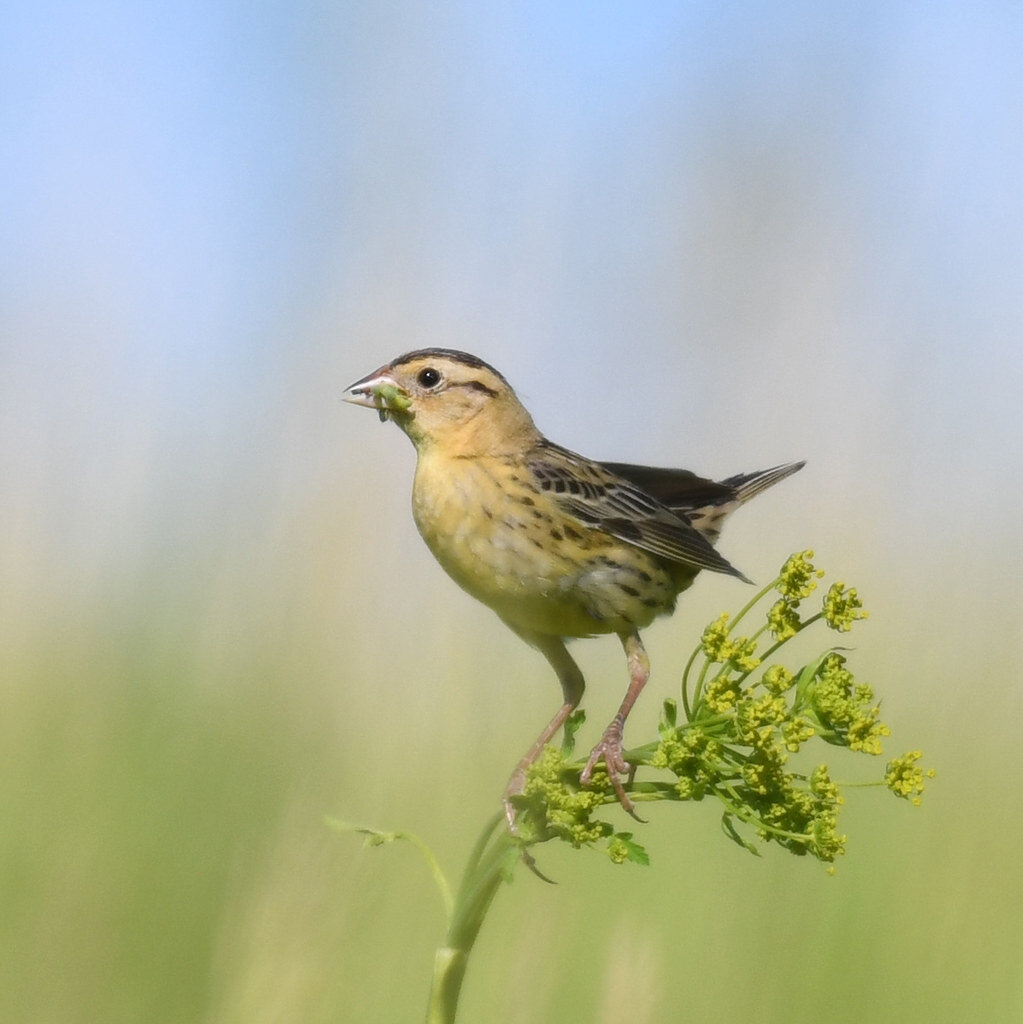This is a reprint of a Friday Feathered Feature we originally published in August 2017, because we all need a reminder of just how cool the bobolink is, right?
A male bobolink perches in a blooming prairie. Photo by Darrell Neufeld FCC
“The bobolink is gone/ the Rowdy of the meadow/ and no one swaggers now but me”—Emily Dickinson, “The Bobolink is Gone.”
Bobolinks are leaving southern Wisconsin at about this time of year, beginning a tremendous migration to the Pampas of South America, a trip of over 6,000 miles.
For all of the fanfare the bobolink's call elicits in May, its exit is matched in melancholy. William Cullen Bryant wrote of bobolinks in his poem “Robert of Lincoln” stating, “Summer wanes; the children are grown;/ Fun and frolic no more he knows;/ Robert of Lincoln's a humdrum crone.”
While Bryant is right—the August bobolink is humdrum, hardly a shadow of its boisterous self—the bird is busy engorging itself with insects and seeds; the weight of a 6,000 mile trip means colossal weight gains for the bobolink as it puts on half of its body weight in fat reserves.
The male marks a mid-May meadow with his male pattern baldness and an exotic tuxedo, white on his back and black underneath. Even more distinctive is his call, which rattles like R2D2, always enlisting a wry smile from those hearing it for the first time in spring.
Bobolink eggs with their lovely purple speckling. Photo by Carolyn Byers
Often overlooked, the female bobolink accomplishes her share of work alone, in subdued brown plumage with brown streaks on her feathers. She builds the nest herself, making a 2-inch cup of grasses and sedges, which can take up to two days. After laying an average of five purple-specked eggs, she alone incubates the eggs.
William Cullen Bryant depicts the female bobolink as dutiful yet boring, a “Quaker wife,/ pretty and quiet.../ passing at home a patient life.” Bryant's “Robin of Lincoln” is “modest and shy as a nun/...one weak chirp her only note/... Nice good wife that never goes out.” Here Bryant perhaps grapples with the formation of a new American nationalism, branching off from Great Britain. He's describing a uniquely American bird and envisioning the roles of man and woman mirroring those of the bobolink.
Years later, Emily Dickinson would modify these ideas and adapt them to her own experiences. In her poem “Some keep the sabbath going to church,” Dickinson instead keeps the sabbath “staying at home,/ with a bobolink for a chorister.” This imagines a new role for women, contrasting Bryant's womanly work as a sort of boring prison and instead making her homely life an innovation and an act of rebellion.
Bobolinks were among the first birds that were discovered to be polyandrous, with a clutch of a single female having multiple fathers. This innovation of the female bobolink is thought to bring about the advantage of having two males to feed the brood. It may also increase genetic diversity. Males will exhibit polygyny, with more than one female mate.
Photos by USFWS Midwest Region
Bobolinks are among our most recognizable grassland birds, but practices in both North and South America have contributed to population declines. In Wisconsin, for instance, conversion from pasture to frequently mowed alfalfa fields has decreased available habitat. Some fields in Jefferson County have been mowed 7-8 times already this year, which provides no opportunity for grassland birds.
In the Pampas, huge flocks of bobolinks are shot and poisoned as they decimate rice fields and farmers' crops.
At Faville Grove, bobolinks find refuge down Prairie Lane, on our expansive floodplain prairies. Catch them soon before they leave. In Martin, Tillotson, and Charles prairies the “rowdy of the meadow” should never leave, should always swagger on June mornings.
____
Written by Drew Harry, Faville Grove Sanctuary land steward








